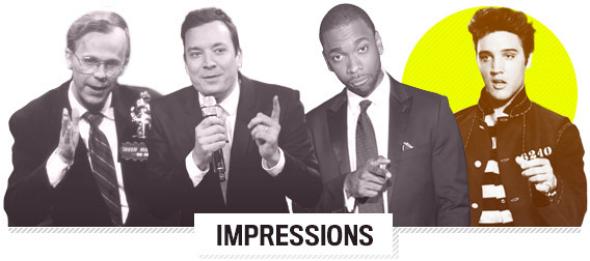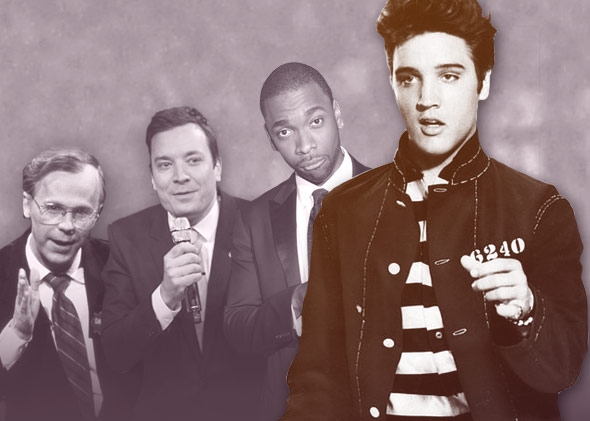Why Elvis Is Our Most Iconic Celebrity Impression

For his new novel The Poser—about a young man with an uncanny knack for imitating others—Jacob Rubin spent a lot of time thinking about what makes impressions work. Pegged to the release of his novel this month, Rubin will be doing a weekly series for Brow Beat on the art of the celebrity send-up. Read the rest of Slate's Impressions series here.
As of 2010, according to the Guinness World Records, there were more than 400,000 Elvis impersonators in operation. The profession has earned its own acronym, ETA: Elvis Tribute Artist. Female, black, Japanese Elvises abound. Kurt Russell has played both Elvis (in the TV biopic of that name) and an Elvis impersonator (in 3000 Miles to Graceland). Bruce Campbell, in Bubba Ho-Tep, played Elvis hiding out as an Elvis impersonator. Nicolas Cage has, for much of his life, seemed to believe he is Elvis. Where do all these Elvises come from? Why are they here? How did Elvis become our most iconic celebrity impression?
To be sure, Elvis Studies is its own sizable territory. Explanations for this imitative impulse are diverse and compelling. Eric Lott has argued that impersonating Elvis is a way for white-middle class men to reclaim a threatened masculinity, albeit in damaged form. Marjorie Garber has likened it to cross-dressing. Greil Marcus describes Elvis as a vision of “pure pleasure”: “you want to feel like that,” he says. “And so you tell yourself that if you dress up like him and I move like him, maybe I’ll get a glimmer of what it must have been like to be in that body, to have that sound come out of his throat.”

A quick look at the documentary Almost Elvis, about the world of ETAs, confirms the deep, libidinous drive among impersonators to inhabit Elvis’s body. Here are several ETAs describing their affinity for the King:
It is interesting to explore why, given these propensities, it has become standard to imitate Elvis at the end of his career (the jumpsuit, mutton chops, Vegas Elvis) rather than, say, the young Elvis of “Hound Dog.” (While some do imitate the younger Elvis, later, older Elvis is far more common and iconic.) If the dream of the impersonation is to capture the lightning id of the man, why immortalize him at the bloated, self-parodying end when he seemed to stand adjacent to death?
A glance at the earliest impressions may give a clue. Jimmy Ellis and Johnny Harra were among the most influential imitators, each of whom seemed mystically anointed to duplicate the King. Here is a recording of Jimmy Ellis doing “Teddy Bear” and “Don’t Be Cruel” with something like Elvis’s baritone. Neither one was Elvis, of course, but each in his way could nibble at pieces of him. Jimmy Ellis had something close to the King’s voice, Harra his looks.
Johnny Harra, who was born with a stutter he claimed went away when he sang along to Elvis on the radio, looked admirably close to Elvis (if with more of a pugilist’s nose). Starting at eleven, Harra was Elvis for 54 years, twelve longer than Elvis himself.
And yet each man’s aptitude for the part mattered, really, only insofar as it could reap big bucks. Jimmy Ellis, in a cynical ploy by Sun Records, performed under the stage name Orion, taken from Gail Brewer-Giorgio’s novel about a singer—a thinly veiled Elvis— who fakes his own death. As Orion, Ellis performed in a mask, and Sun Records released some of his recordings in intentionally ambiguous circumstances, to imply that the King might still live. Meanwhile, in 1977, just after Elvis’ death, the look-alike Jimmy Harra was given a $6 million contract (money he was allegedly cheated out of) to perform as Elvis at the Silverbird casino in Las Vegas.
In light of such history, the choice to portray the later Elvis makes perfect sense. Each impression existed to artificially (and lucratively) extend Elvis’s life. The reinstatement of a younger Elvis would have crucially bungled the narrative. It is hard not to read at least the origins of the ETA industry as an extension of the larger process of controlling—if not outright denying—the circumstances of Elvis’s death, an effort that began the moment the singer died.
If you search for “how did Elvis die,” the first answer Google gives is: cardiac arrhythmia. This isn’t true. Joel Williamson has written about how Elvis’s very clear overdose was given this false, anodyne label, sanitizing what was a very disturbing end to the beloved star’s life. Ellis’ and Harra’s acts seem to take this whitewashing one step further: not only did Elvis not die of an overdose, he did not die at all! He faked his death and is wearing a mask (Ellis); he is in residence, in perpetuity, in Vegas (Harra).
In case you doubt whether those who came to see these early impersonators were invested in the illusion of a living Elvis, check out this footage of Harra performing.
Yes, these are fans pulling at the scarf of a man they know to be a mimic. Here we see the force of the denial, or perhaps denial transmuted into an emotive devotion. Elvis lives! Even better, he is preserved right at the moment before death. He has all the benefits of being dead—he is static, mysterious, authoritative—with none of the cons, namely, being absent or diminished. He is a kind of immaculate corpse, a hip-swaying statute in a wax museum, cleanly separated from any real, suffering person.
In an earlier post, I argued that impressions are a kind of synecdoche. So is celebrity, which makes of complex—and sometimes unhappy—people what we call “icons.” We might also call them silkscreens, silhouettes, images, or posters. The process of becoming famous is a process of becoming a kind of object, and, in America, a familiar kind of object, usually: that is, a product. Impressions of celebrities abet this process, making the already-reduced all the more recognizable and transmissible.
It’s telling, for instance, that ESPN recently hired Frank Caliendo to be its in-house mimic. You might think this is so the note-perfect performer can ape figures the network covers, such as terse Bill Belichik or semi-ridiculous Jim Harbaugh, and Caliendo, indeed, does. But ESPN seems equally interested in having Caliendo mirror its own gallery of suits. In this clip, for instance, Caliendo goes halfsies—three popular sports figures, three ESPN commentators, with one Morgan Freeman for good measure:
The equal emphasis is telling. ESPN seems to believe Caliendo can almost literally increase its human capital. By popularizing imitations of talking heads like Mel Kiper and Adam Schefter, Caliendo helps to confirm their status as celebrities.
Mimics, in this regard, can serve as human mints, yet mints of a peculiar kind in that their work doesn’t lessen the value of what they print. They are walking analogues to the mechanical reproductions of Walter Benjamin’s canonical essay, making a figure both more valuable and common. As Benjamin argues, the more a work of art is reproduced, the more the original’s “aura,” its unique situation in space and time, is enhanced. Just the same, no matter how uncanny, the mimic won’t threaten the original’s aura. As Charles Barkley has said of Caliendo’s impression of him: “Every time you do it, I make more money.”
Here, then, we see another use for the myth that Elvis is still alive: It imbues the ETAs with a kind of plot. If the replications are still dependent on the original for its glow, they would be pale without the rumor that the King still lives. The possibility of happening upon the real Elvis, among all these imitations, is like the hope of landing upon the prize in the Cracker Jack box. You might find it anywhere. Elvis may now be Chinese, or Middle Eastern. Hell, you might be him yourself.
Dana Carvey as George Bush by Alan Singer/NBC/NBCU Photo Bank via Getty Images, Jimmy Fallon' by Theo Wargo/Getty Images for The Tonight Show Starring Jimmy Fallon, Jay Pharoah by Larry Busacca/Getty Images, Elvis Presley/ Metro-Goldwyn-Mayer, Inc./Library of Congress.
